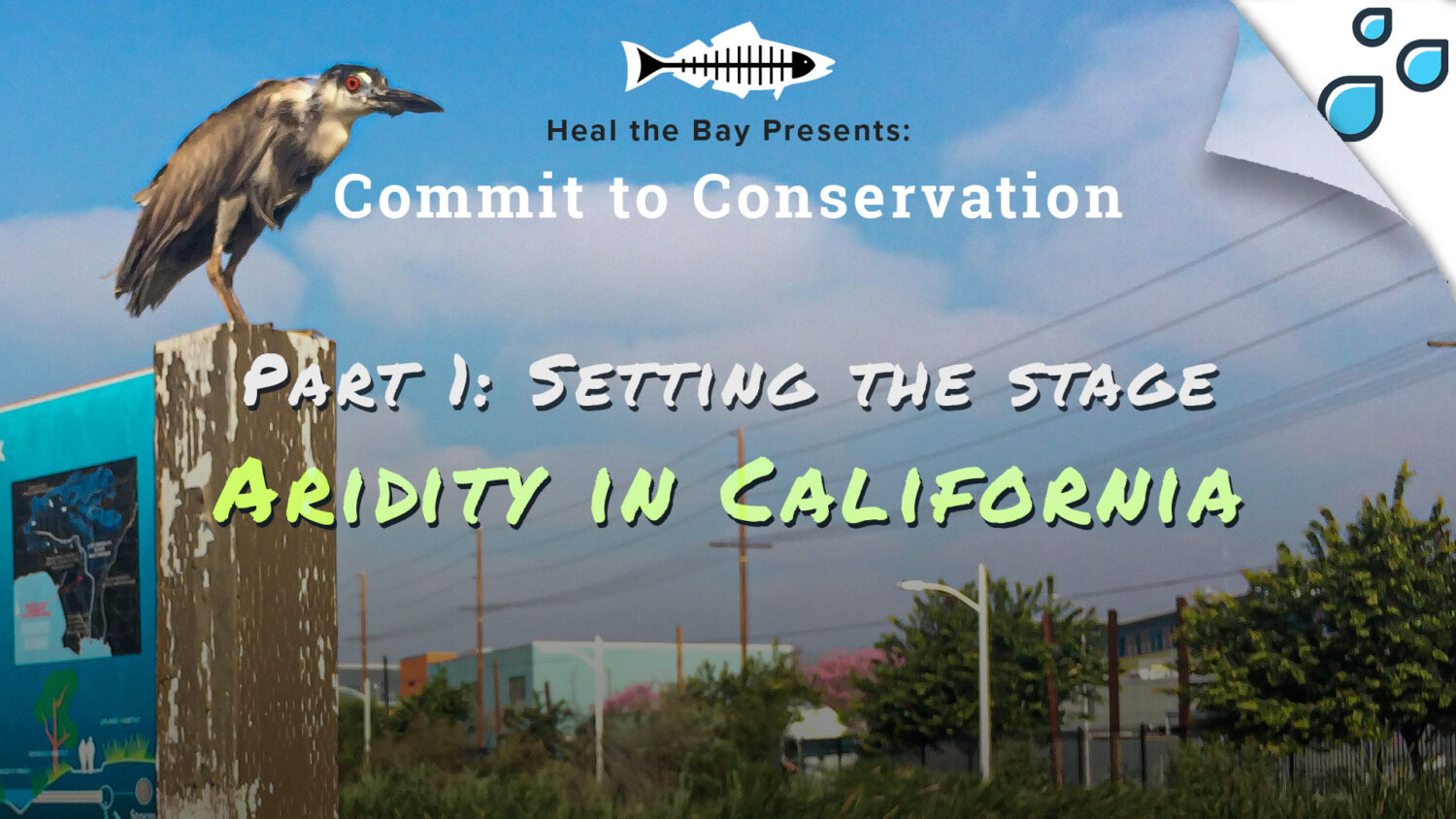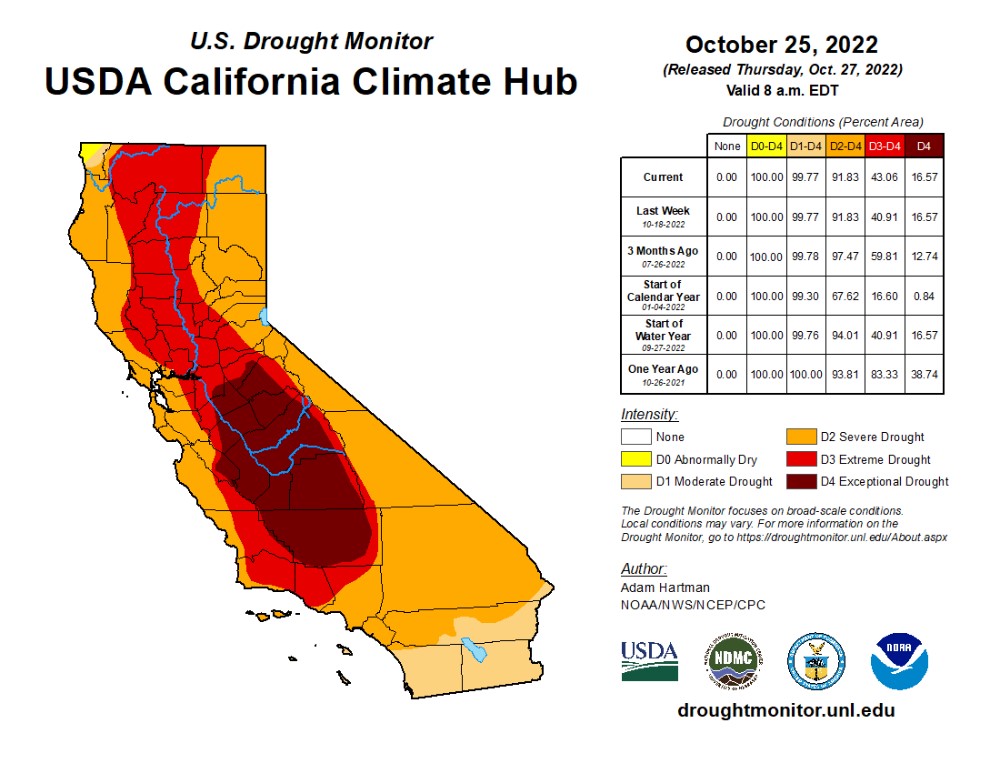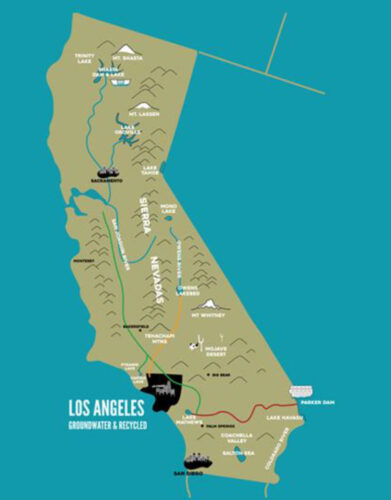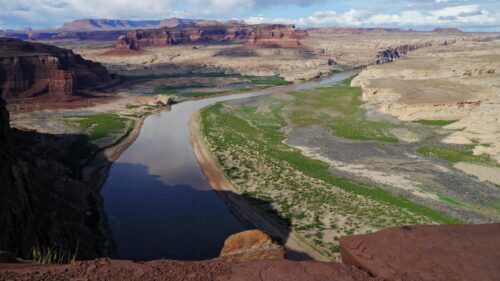Commit to Conservation Part 1: Setting the Stage – Aridity in California

In Part 1 of our 3-part series, Commit to Conservation, Heal the Bay Water Quality Scientist Annelisa explains how smart water practices like recycling and conservation can help ensure the human right to water and the rights of nature, even as California becomes more arid.
MANY FOLKS LIVING IN CALIFORNIA are all too familiar with drought, because it seems like we are always in one. I was born and raised in California, so drought conditions have been a part of my life for as long as I can remember. I learned to turn off the faucet while I brushed my teeth, to limit my showers to 5 minutes or less, and to never let a drop of water go to waste. Many California residents have gotten really good at conserving water when drought is in the news, but we are not as familiar with the why behind it all, so those good water practices often fall away as soon as we get some rain. Unfortunately, one good rainstorm — or even a few — is not enough to end a drought, nor is it enough to prepare for the next one. Drought cycles have always occurred in California, and they continue to worsen as the climate crisis persists, due in part to a process called aridification that is making our dry years even drier. What we consider “normal” is constantly shifting, and then we still get periods of drought on top of that. In this blog, we will start to explore the why behind all of our conservation efforts, and what that means for Los Angeles’ water future.

A map of drought conditions in California, as of October 18, 2022. This map shows exceptional drought conditions (the highest level of drought severity) in the Central Valley. All of California is experiencing some level of drought conditions, and the majority of California is experiencing severe, extreme, or exceptional drought conditions. Source: U.S. Department of Agriculture
Water Management in Los Angeles

Where does LA Water come from? Source: Know the Flow / Heal the Bay
Roughly 80% of LA’s water is imported from hundreds of miles away in the Northern Sierra Nevada mountain range and San Francisco Bay Delta via the CA Aqueduct, the Eastern Sierra and Owens Valley via the LA Aqueduct, and the Rocky Mountains via the Colorado River Aqueduct. Most of this imported water starts as snowpack in the mountains. In fact, California’s water system was designed so that the snowpack would be our biggest reservoir, with the Sierra Nevada (which translates to snow-covered mountains in Spanish) alone holding 30% of California’s water. The snow would build up in the winter, and then slowly melt over the spring to fill reservoirs, recharge groundwater aquifers, and flow through our aqueducts so that we have water supply when we need it most in the summer and fall, at which time the cycle would start all over again.
While we continue to take water from critical ecosystems like the Bay Delta, Owens Valley, and Colorado River Delta, which also need that snowmelt, we flush away the water that is available to us locally. Even in dry weather, 10 million gallons of water flow through Los Angeles’ stormdrain system and out to the ocean every single day just from nuisance flow (e.g., broken sprinklers, washing cars, hosing down driveways). And then, when we do get rain, that flow number surges with stormwater runoff, averaging 100 billion gallons of water wasted each year, when it could instead be captured and put to beneficial use. In addition, hundreds of millions of gallons of treated water is discharged from our wastewater treatment plants each day. Some of this treated water flows to the ocean through rivers and streams, and at least some of this flow may be needed to provide critical habitat for ecosystem health. But the treated water that is discharged directly to the ocean provides no beneficial purpose.
To learn more about the LA Aqueduct and its effects on local peoples and ecosystems, watch The Aqueduct Between Us, directed by AnMarie Mendoza from the Gabrieleno-Tongva Tribe.
Water Resources in Los Angeles Change with the Climate
Climate change is happening now. We are seeing and feeling the effects every day with relentless record-breaking heat waves, floods, fire seasons, and droughts. We already experience what is called weather whiplash: dramatic swings between extreme weather patterns. Climate change continues to intensify these swings, so our dry years are hotter and drier, and our wet years are even more intense. More frequent dry years and hotter temperatures drive demand for water up (it takes more water to irrigate crops and landscapes), depleting water supply. Evaporation also takes its toll by pulling water from reservoirs and even taking moisture up from the land, which weakens ecosystem health and actually makes it harder for the land to absorb water when it does rain. Add longer and more intense droughts into that mix, and it is clear that California is becoming more dry (or arid) over time. This process is called aridification, and the trend will only increase as human-accelerated climate change continues.

Low flow in the Colorado River, Source: Vicki Devine / Center for Biological Diversity

Critically low snowpack in California. Source: Stephanie Elam / CNN
Despite this dire news, it does still rain in Los Angeles. Looking ahead, we actually expect to get the same volume of rain locally on average as we have in recent history, but it will fall less often through heavier downpours. In addition, our dwindling snowpack reservoirs are melting faster each year. We do not currently have the infrastructure in place to capture that higher level of runoff from intense storms and fast snowmelt. This all means that more water will flow back to the ocean rather than being stored as snowpack, or infiltrated into groundwater reservoirs. Some people have suggested that more surface reservoirs are the answer, but they are excessively expensive. Much of the stored water would be lost to evaporation, and quite frankly, we have already dammed most of the rivers in CA. So we must rethink how we manage water to make the most of the resources we do have left.
Water Management in Los Angeles Must Change, Too
While we will continue to experience aridification and weather whiplash, we can still adapt to this hotter, drier future. To do this, conservation cannot only happen in response to a drought designation, but it must be a way of life. The good news is that there are local and sustainable solutions that individuals can do at home (indoor and outdoor) and systemic changes that we can push for together to be water wise.
We can source enough water locally to support our water needs and drastically reduce our reliance on imported water. This can be done through improving water conservation/efficiency both regionally and at home, groundwater cleanup, stormwater capture, and wastewater purification, without turning to expensive, energy intensive, and environmentally harmful practices such as ocean water desalination. Additionally, there is an opportunity to use nature-based solutions that capture and infiltrate water naturally to support overall ecosystem health, which, in turn, can help to mitigate the impacts of the climate crisis, among myriad additional benefits. In this way we can ensure the human right to water so people can stay safe and healthy, and respect the rights of nature by keeping our ecosystems thriving.
 Nature-based solutions for stormwater capture. Source: Heal the Bay
Nature-based solutions for stormwater capture. Source: Heal the Bay
Do What You Can When You Can – Stay Informed
Issues of California’s dwindling water supply, increased demand, and uncertain reliability can feel overwhelming. But we are not powerless in this climate crisis. We can all take the Climate Challenge to do what we can when we can. Start today and focus on “what we learn” — or whatever resonates with you. You can stay informed. Heal the Bay can help.
Over the next six months, Heal the Bay will be exploring what it means to live in an arid state, and what climate change, drought, and aridification mean for our water future. We will share solutions and opportunities for advancing water efficiency to become more water wise at home and as a community through collective and regional action. Stay tuned for more content! In the meantime…
💥ASK THE EXPERTS: What do you want to know? Ask our staff scientists any questions you have about aridification, drought, and water conservation. Your answer may be featured in an upcoming blog post or video from Heal the Bay.
ACTION LINK(S)
ATTEND BLUE TABLE TALK ON DROUGHT
Written by Annelisa Moe. As a Heal the Bay Water Quality Scientist, Annelisa helps to keep L.A. water clean and safe by advocating for comprehensive and science-based water quality regulation and enforcement. Before joining the team at Heal the Bay, she worked with the Regional Water Quality Control Board in both the underground storage tank program and the surface water ambient monitoring program.



 Nature-based solutions for stormwater capture. Source: Heal the Bay
Nature-based solutions for stormwater capture. Source: Heal the Bay